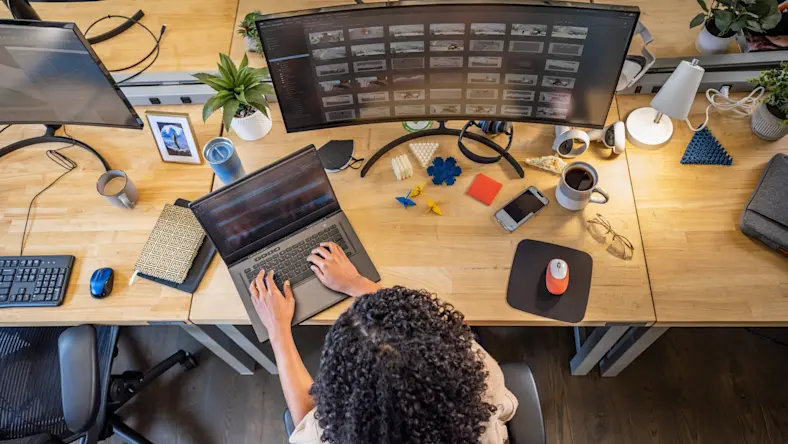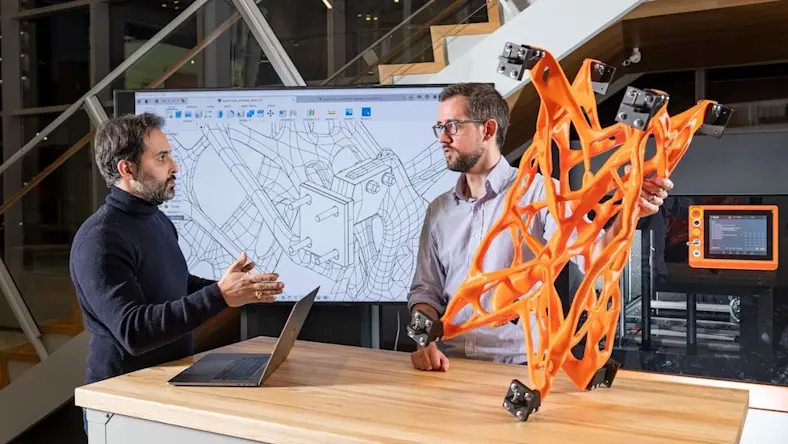& Construction

Integrated BIM tools, including Revit, AutoCAD, and Civil 3D
& Manufacturing

Professional CAD/CAM tools built on Inventor and AutoCAD
Narrator: In the world of human-powered vehicles (HPV), it’s all about speed. The current world record is 89.59 miles an hour, set here: Battle Mountain, Nevada. Two great rivals of the HPV world—veteran designer and rider Mike Burrows and engineer Glen Thompson—came together a few years ago after deciding at a close friend’s funeral to collaborate for the first time and, at one last effort, aim to create a bicycle that could travel at over 90 miles per hour.
Mike Burrows, Designer: The computer has done a lot of modeling for us, and it suggests that based on my power output, rolling resistance of the tires, and the aerodynamics … it’s possibly the most streamlined thing in the world, as it stands at the moment. But then there’s still quite a few unknowns, I suspect.
This is the chassis that will go inside, and we’ve quite consciously chose a separate chassis shell. The steering is unlike a conventional bicycle. I’m pushing—that’s the axle; I’m simply pushing the axle back and forth on one side. It’s rotating just inside there. There’s a spherical joint inside the wheel, which means that the chain is unaffected by the steering.
Just the one gear, which a lot of people think you need gears to go fast, and you don’t; you just need the right gear. One of the interesting things has been working out what we know about things aerodynamics do in geometry. You always know the unknown unknowns, famously, and they all seem to come back to the human element.
Narrator: Testing the bicycle, now known as Soup Dragon, was critical as the team prepared to go to the annual event at Battle Mountain. Barney Townsend, Thompson’s colleague from South Bank University, collaborated with Autodesk, to help develop the outer shell of the bicycle.
Barney Townsend, Engineer, South Bank University: We’ve used the software as a fundamental modeling tool throughout the project, apart from, of course, the first frame designs, which were done in a completely analog way by Mike Burrows, who doesn’t use CAD software. It enabled us to have a lot of confidence and faith in our reverse engineering of his initial designs to build out the digital model, to examine various characteristics of the steering system and all sorts of various mechanical elements. But we’re very excited to see where the generative-design capability will lead us. It slightly turns the designs and structural-analysis process on its head a little bit. You’re looking at it from the opposite end of things and asking the computer to do the work that you would have probably done in the past.
Narrator: Before the team’s departure, Burrows, who is 75, decided he would not go to Battle Mountain.
Burrows: I don’t feel right in it. The handling and everything, the geometry, it absolutely does work as far as I’m concerned. We built a brilliant machine; it’s just, I’m not the person to ride it.
Narrator: He would, however, help find another rider. Russell Bridge stepped in at the last minute.
Russell Bridge, Soup Dragon Rider: I’m relatively the same size as Mike. I think my feet are slightly bigger, so I’m slightly nervous about my feet fitting in there. I’ve done it for about five, six years. I’ve ridden a couple machines in the race series there. We normally do 13 to 14 races a year.
Narrator: The team traveled out to Battle Mountain, Nevada, knowing they had a great design in Soup Dragon. But with a new rider, it would be an uphill struggle to attempt to break records. It turned out, this was only the beginning of their difficulties. Soup Dragon was never delivered to the team but ended up in Reno, a three-hour drive away.
Townsend: We have her. Thank you so much.
DHL Employee: You’re welcome.
Townsend: You have saved our trip.
DHL Employee: Awesome.
Narrator: When the team eventually found her safe and sound, in a cruel twist, it appeared disaster had struck.
Glen Thompson, Lead Engineer, South Bank University: The nose is just completely smashed in. The back tail’s got a big tear in it. It’s not that bad actually. From the photographs it looked awful.
Soup Dragon Team Member: Yeah, I know, I thought it was, like, half the body.
Townsend: How’s that feel in terms of height of the handlebars? Obviously, we put it back in best we could.
World Human-Powered Speed Challenge Official: So Soup Dragon, I’m starting your four-minute clock.
Two minutes.
Soup Dragon is on the course. Soup Dragon is on the course, and it just successfully rejected the landing gear, as well, so it is a bike.
Challenge Attendee: That was beautiful. We love that landing gear.
Bridge: So scary. I was moving around so much. I was all over.
Challenge Official 2: So we had Russell in Soup Dragon. 93, I mean, 53.81 legal wind. That’s a 15-mile-an-hour hat.
Challenge Attendee 2: Well, it’s like you said, you came here to learn this year. I know you’ve learned a lot. And so next year, you beef the thing up, make it a little more sturdy if you need to, and you get a rockin’ run.
Townsend: From the data that we’ve got, we know that the core design principles that we based this on are good.
Thompson: We can now go back and can take those principles and really develop them and build them a much stiffer bike.
Narrator: As with all journeys, this one has a way to go. The team is now working alongside more students at South Bank University in London using Autodesk Fusion 360 software. Maybe next year in Battle Mountain, Nevada, history will be made.
Executive insights
PD&M
Emerging Tech


